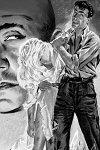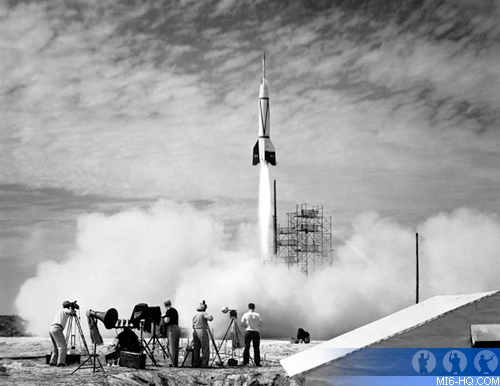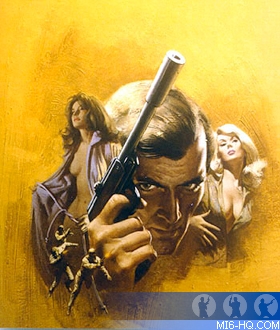 |
| |
50 years since its first publication, MI6 reflects
on the back-stories, Cuban connection
and
press reaction to Ian Fleming's sixth novel, Dr.
No... |
|
Worlds Collide - The Legacy of Dr. No (2)
8th April 2008
"Dr. No" sees
007 travel to the islands of Jamaica,
still recovering from a poisonous jab from Rosa Klebb, and investigating
the mysterious circumstances surrounding the disappearance of
MI6 agent, Strangways. What was supposed to be a jaunt in the
sun for Bond turns into his most grueling, inhumane assignment
yet. 007 and the young, beautiful Honeychile Ryder have to fight
for their lives as the island of Crab Key unleashes its darkest
threats!
50 years ago this month Ian
Fleming's sixth James Bond novel was unleashed on the British
public. Half a century later, MI6 delves into the back-story,
inspirations and real life scenarios that inspired the classic
007 adventure. Previously, MI6 looked back at Ian Fleming's writing
style, methods and real life inspirations for his sixth novel:
 Fairytales For Grown-ups - The Legacy of Dr. No (1)
Fairytales For Grown-ups - The Legacy of Dr. No (1)
Worlds Collide
"Dr. No" sees not only its setting built on real life
experiences, but also a plot and villainous scheme which resonates
in fact -
or at least the very real concerns of the time. Nuclear fear was
spreading quickly throughout the modern world. The Cold War drummed
on as a backdrop beat to 007's every move, and on this occasion
Dr. No's efforts
to topple US missile tests only embodied the tense atmosphere.
Fleming's story rode on the wave that captured both America
and Britain too - the suspicion of Cuban nuclear armament.
Within the fog of fear, there's no certainty that Fleming wrote
out of an intent to echo the issues close to home, or whether
he was simply and subliminally influenced by the ongoing chatter.
Regardless, Fleming concocted a tale that was imprinted on every
reader's memory and certainly rang true
to the attitudes of the period.

Above: Spectators watch as the first
missile is launched at Cape Canaveral in 1950... |
1958 would not be the end of Fleming's Cuban
connection. Having predicted something of the conflict to come,
Fleming was invited to dinner with John F. Kennedy, during
the period when the young Kennedy was Senator was running for
Presidential office. The year was 1960 and over an elaborate
dinner with the
politician, Fleming was beckoned to discuss an original idea
for keeping Castro "at bay".
An outrageous explanation ensued from Fleming who told Kennedy
he should arrange for the air force to drop pamphlets to the
Cuban people, advising them that their territory had become radioactively
unstable and that the nuclear fallout primarily effected men
with beards, and as "everyone" knows radioactivity
makes a man impotent. Fleming explained his reasoning that with
this news, every Cuban man would instinctively shave their beard,
and without bearded Cubans there could be no revolution!
Quotable
On the 31st of March 1958, Ian Fleming's Jamaican extravaganza
hit the bookshelves to a
variety of reviews from regular Bond readers and literarily
critics alike. Popular novelists outwardly praised Fleming's
latest novel: Raymond Chandler described Fleming's work
as "masterly", and
Elizabeth Bowen said of "Dr. No", "here's magnificent
writing". However, the overall press reaction was more
analytical.
As America prepared to welcome back 007,
block quotes of the day proclaim Fleming's sixth novel
an "unprintable
book that is at last readable". While the focus of
negativity is still strongly surrounding the glorification
of drinking, smoking and so forth, reviewers recognise
some of Fleming's best characterisation in the "rich
man's Fu Manchu", Dr. No.
"At last, an unprintable book that is readable."
|
|
 Above: Fleming relaxes behind his famous desk at GoldenEye estate, Jamaica...
Above: Fleming relaxes behind his famous desk at GoldenEye estate, Jamaica...
|
However, considering the era, 007's latest run-in
sees many shocked by the in-depth descriptions of the psychotic
Doctor's obstacle course - intended to investigate however much
pain a man can handle. Time Magazine reported that New Statesman's
Critic Paul Johnson suggested that Fleming fans were psychosocial
cousins of prison torturers in Algeria.
 |
|
Not all reviewers saw 007
as stale snobbery or unprintable melodramatics, though.
The Spectator praised "Dr. No" from a literary
perspective: "Fleming,
by reason of his cool analytical intelligence, his informed
use of technical facts, his plausibility, sense of pace,
brilliant descriptive powers and superb imagination, provides
sheer entertainment."
"...a cunning mixture of sex, sadism and money snobbery!"
On the whole, "Dr. No" was successful
in proving a turning point for 007 and encouraging the
media to address the overly successful spy genre for what
it was: fairy tales for grown ups. As for Fleming, he
neither read nor commented on any attention the press were
giving him, for as the world was preparing to receive James
Bond's latest adventure - Ian Fleming was preparing his
next - "Goldfinger".
|
New Home
Today, the home Ian Fleming's original "Dr. No" manuscript
- a 206 page manuscript
bashed out on his typewriter and heavily corrected in ink
- resides in the famous Lilly Library, located in the heart of
Indiana University,
Bloomington, USA. Several
titles
differ from any published version to date: "Hear You Loud
and Clear", the opening chapter of "Dr. No" is branded "The
Quick, Neat Job" in this draft. The final line also differs
from what fans would remember: "Do what I tell you" is
later substituted in the final copy as "Do as you're told".
Related Articles
 Fairytales For Grown-ups - The Legacy of Dr. No (1)
Fairytales For Grown-ups - The Legacy of Dr. No (1)
 Ian Fleming
Ian Fleming
 Dr. No
Dr. No
 Literary Articles
Literary Articles